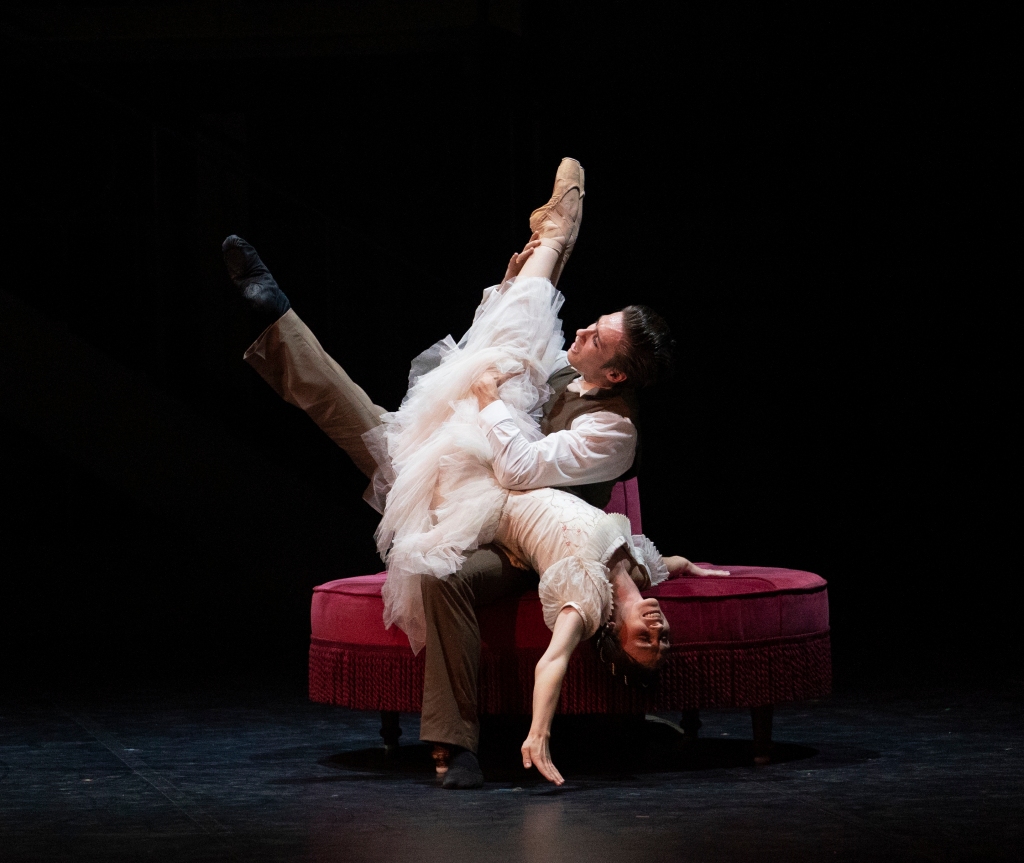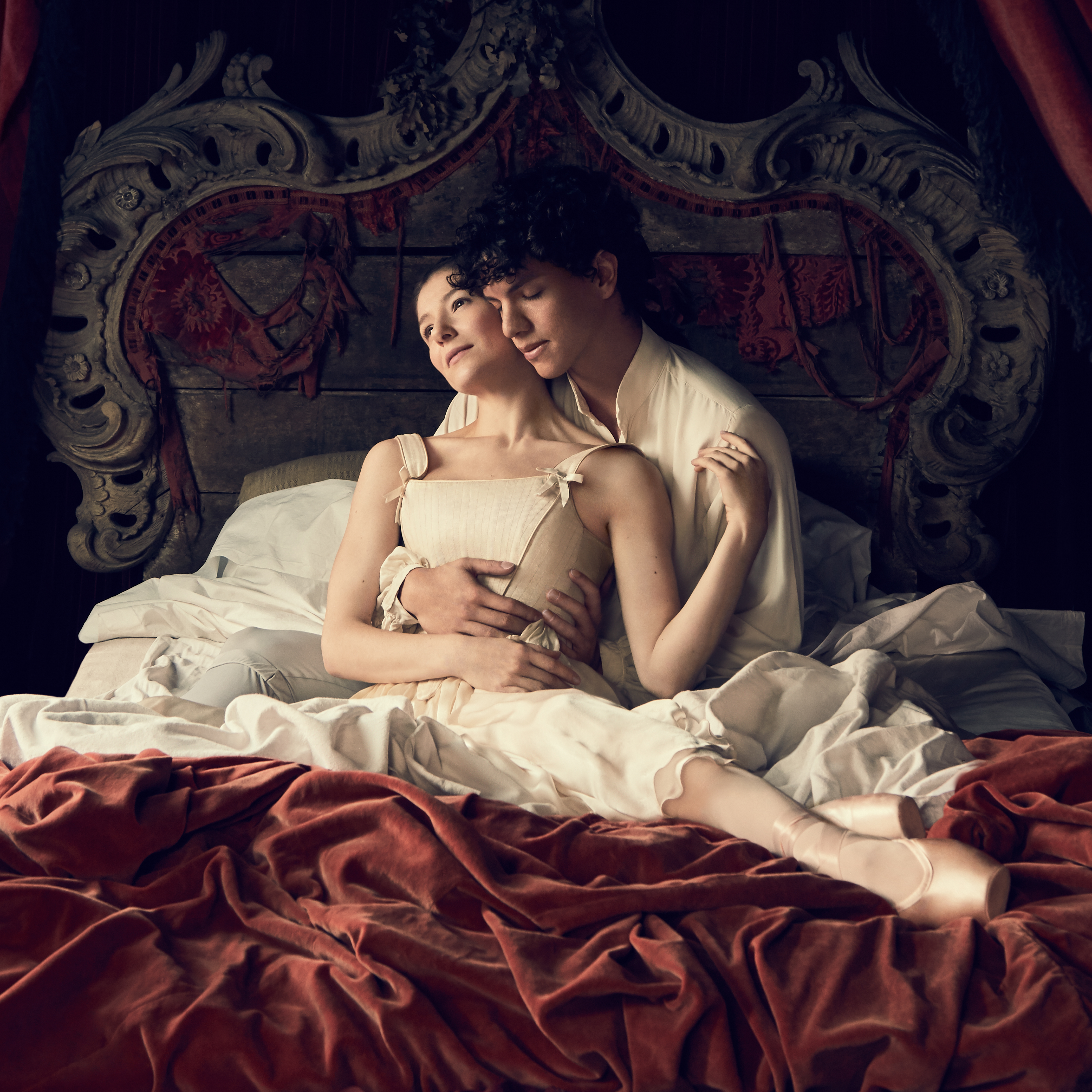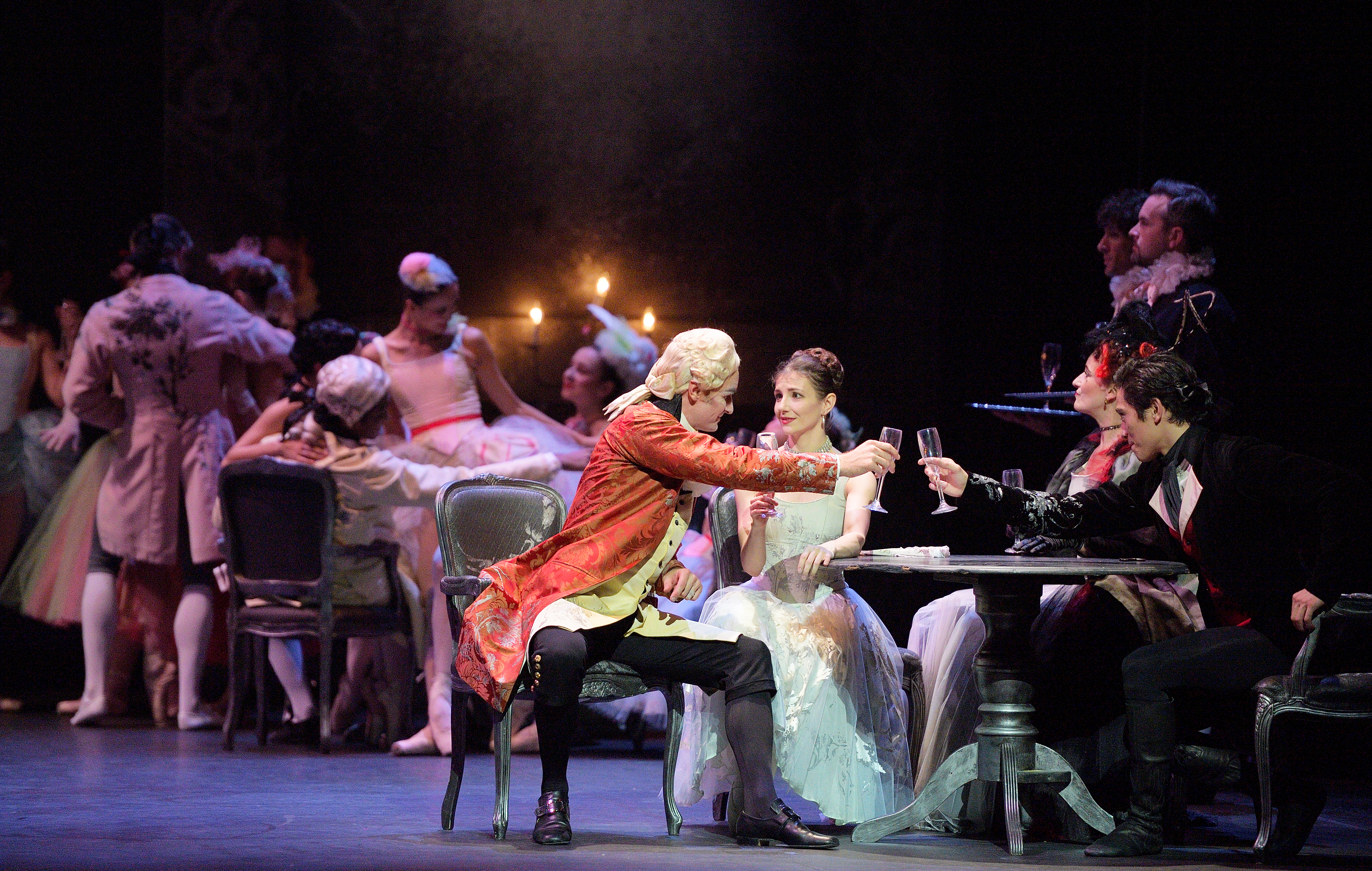Biographical Ballets Now
When we started researching biographical ballets, we were under the impression that such ballets were a rarity. Fortunately however, discussions with friends and colleagues revealed a multitude of works, including forgotten and unknown examples, demonstrating that, as in cinema, people’s lives offer a rich source for creation in ballet.
Internationally a number of recent biographical ballets have been based on the lives of iconic figures from the arts, amongst them Broken Wings (Lopez Ochoa, 2016), based on the life and work of Frida Kahlo; John Neumeier’s Nijinsky and Yuri Possokhov’s Nureyev, both from 2017; and Morgann Runacre-Temple’s The Kingdom of Back (2018) about the relationship between Mozart’s elder sister Nannerl, also a composer, Mozart himself and their father.
Our focus for this post is of course driven by the successful addition to the British ballet repertoire that is Cathy Marston’s Victoria for Northern Ballet. Monarchs and royals are no strangers to the ballet stage. Kenneth MacMillan devoted full-evening works to exploring the lives of the Grand Duchess Anastasia Nikolevna of Russia (Anastasia, 1971) and Rudolf, Crown Prince of Austria (Mayerling, 1978) in his inimitable full-blooded style. Between these two ballets, in 1976, came Peter Darrell’s Mary Queen of Scots, while in 1995 David Bintley tackled the subject of Edward II through the lens of Christopher Marlowe’s 1592 play. On a smaller scale is the more recent Elizabeth by Will Tuckett (2013), but this choreography incorporates spoken and sung text, as well as onstage musicians.
Like Elizabeth I, Queen Victoria is such a familiar figure to us. Even if we never learnt about her in school, there are documentaries and films available, as well as the current ITV series Victoria, now having completed a third series. Literature is aplenty in the form of both biographies and fiction, diaries and letters, and a Christmas never goes by without a reminder of how she and Albert established family traditions such as gathering round a decorated Christmas tree. In everyday London life their names crop up repeatedly: Victoria Station, the Victoria line, the Victoria and Albert Museum, the Royal Albert Hall, the Albert Memorial, the Victoria Memorial. To say nothing of the numerous statues of Victoria throughout the UK …
But Queen Victoria reigned for over six decades, and writings by her and about her were carefully edited. She had a hugely important public persona to develop and project, as well as a private life to lead with its famed tragedies. Consequently, she is frequently portrayed in conflicting ways, which we definitely experienced as we watched documentaries in preparation for this post (“Queen Victoria’s Letters” 1&2; “The Secret Life of Queen Victoria”; “Queen Victoria’s Children 1,2,3”; “King Edward Parts 1&2”). So how can a choreographer create a ballet about Victoria, who was celebrated as wife, mother and widow, as well as empress and queen, over so many years of political change, in a single evening?
The solution that Cathy Marston and librettist Uzma Hameed came up with was to portray Victoria from a very specific perspective – that of Beatrice, Victoria’s youngest daughter. This enabled a sufficiently narrow focus for a two-act ballet, with a selection of a restricted number of characters and events covering the many decades from Victoria as a young woman prior to ascending the throne right up to her death.
While the notion of “narrowness” and “restriction” may initially seem limiting, if you think about it, this process of paring down is absolutely essential in any adaptation that involves a change of medium necessitating any substantial change in length or duration, such as the adaptation of an 800-page book into a 100-minute film, or years of a person’s life into a 300-page volume. Such are the skills necessary to achieve a process of adaptation of this kind, that they have been referred to as a “surgical art” (H. Porter Abbott qtd. in Linda Hutcheon and Siobhan O’Flynn 19).
Victoria premiered on March 16th of this year, and has received a substantial amount of media attention, including interviews with the choreographer, articles, and numerous reviews. Therefore, the fact that the ballet is framed by Beatrice’s rewriting of her Mother’s diaries and presented in flashbacks following Beatrice’s reading in the diaries is well documented. Some of the reviews stand out to us in the way they highlight the writing and rewriting of history (King, Lowe, Monahan, Roy, Winter). Unsurprisingly, this topic of how history is written is close to our hearts, although for some Marston’s delight at finding an “unreliable witness” (qtd. in Dennison) to Victoria’s life may come as a surprise. However, to us this seems to be at the heart of the ballet, not only in how it portrays the events of Victoria’s life, but how it challenges some of our preconceptions of Victoria, and therefore startles and stirs us in equal measure.
If you have been following the ITV series Victoria, you will be familiar with the passion of the young Victoria; however, we see nothing in the series to compare with the sheer sexual pleasure expressed by Marston’s choreography for Victoria and Albert’s wedding night duet (“Northern Ballet’s Victoria”), which on one occasion in our viewing elicited a “wow!” from the audience.


Similarly, our pervasive awareness of Victoria’s love for her consort may inhibit our ability to connect such passion with the disagreements over Albert’s role in politics. With characteristic economy of means Marston conveys these turbulent arguments through tussles over a red box symbolising affairs of state. But in the ballet Victoria’s intransigence is seen at its most passionate in her furious resistance to Beatrice’s desire to marry: bent over double with fists clenched, her rage is palpable. And while we may indeed envision Victoria as domineering and controlling, the ferocity of her physicality collides with the conventional image of Victoria.
Watching Marston’s Victoria makes us feel on the one hand that we’re learning more about the iconic monarch, but on the other hand the experience of having our well-worn vision of Victoria challenged is destabilising. Consequently, and counterintuitively, Victoria seems to become more of a mystery than previously. Perhaps this is because Marston presents her as a human being – as daughter, lover and mother, as well as queen and empress. But equally, because we so clearly witness her through layers of subjectivity. Marston makes this crystal clear through her words in interviews and rehearsals, and no less through the stage action itself. Victoria writes, and Beatrice reads, remembers, discovers, reacts and edits: the lives of Victoria and Beatrice written by Victoria and rewritten by Beatrice with nostalgia and longing on the one hand, and surprise, disapprobation and anger on the other.
Biographical Ballets Then
Unlike in the case of Queen Victoria, the royal lives that MacMillan chose to adapt are probably perceived by British audiences as more than usually mysterious. This is particularly the case for Grand Duchess Anastasia Romanova, who was believed by some to have survived the massacre of the Imperial Russian family by the Bolsheviks in 1917. But the circumstances of Crown Prince Rudolf’s death, the last of the Habsburg dynasty, was deliberately covered up for political reasons and therefore also shrouded in mystery. This sense of mystery has perhaps been intensified by the highly romanticised 1956 Anastasia featuring Ingrid Bergman in the titular role, and Mayerling with Omar Sharif and Catherine Deneuve (1968).
What probably attracted MacMillan to these two historical figures was his inclination towards sombre subject matter and characters who experienced a sense of being an outsider – a theme that MacMillan revisited repeatedly (Parry “Creating Anastasia” 4). But in both cases, as we watch, we gain a sense that the creators were intent on revealing some kind of perceived truth through the ballets, that they were committed to uncovering a mystery and replacing it with historical “reality”.
MacMillan created what was to become the final act of Anastasia in 1967 during his time as Director of the Deutsche Oper Ballett in Berlin. The German city was rife with stories of a woman named Anna Anderson claiming to be Anastasia Romanova, youngest daughter of Tsar Nicholas II, a woman frequently referred to as “Fräulein Unbekannt” (“Miss Unknown”) (Welch 8). Anna had been saved from drowning in a Berlin canal in 1920 and had been living in Germany ever since, and from 1932 striving to legally prove her royal identity (Parry “Creating Anastasia” 4).
This one-act ballet was set in a mental hospital, where Anna is seen reliving life as a member of the Imperial family before the Russian Revolution, and witnessing the assassination of her family before being rescued. Flickering film footage of the Imperial family and Russian political events accompanied by a musique concrète score of fractured, distorted voices and harsh, jarring sounds opens the work. This moves into Bohuslav Martinŭ’s dissonant Symphony No. 6 which complements MacMillan’s visceral, angular and splintered movement material, revealing Anna’s emotional turmoil. Her battle to be accepted as Anastasia is exacerbated by memories of her turbulent personal history, which includes the loss of a husband and child.

Figures from her past – her parents, siblings, Rasputin, Bolshevik soldiers –haunt her, randomly emerging and re-enacting crucial events; at times they are confused with her present alienating company of medical staff and visitors. The theme of the outsider is patently clear: Anna is segregated from any potential community in her current life by the four walls of her hospital room, and she is segregated from the community of her past through their death.
Four years later when MacMillan was working as Artistic Director of the Royal Ballet, the choreographer developed the one-act work into a three-act ballet, portraying the Imperial family in events leading up to World War I (Act I) and the 1917 Revolution (Act II). Although the flashbacks that fill Anna’s mind in the final act are fragmented and muddled, indicating her state of mind, the first two acts follow a clear chronology. Therefore, the characters who haunt her in Act III are initially presented logically and in context, conveying to the audience a sense of factual reality. This means that there is no disconnect between Anastasia’s historical past and Anna’s memories, giving credence to Anna’s claims. And the final moments seem to confirm this: “At the end of the ballet, she stands like a ship’s figurehead at the prow of her bed as it sails round the stage, a small defiant figure floating on a sea of darkness” (Parry Different Drummer 327).
Gillian Freeman, who wrote the scenario for Mayerling, organised three acts that cover the last eight years of Rudolf’s life from his wedding day to his suicide with his young mistress Mary Vetsera. Rudolf’s troubled relationships with women, from his mother and wife to his various mistresses provided rich material for transforming into expressive pas de deux, one of MacMillan’s great talents as a choreographer. It is abundantly clear that the choreographer wanted to portray Rudolf as a tormented human being who had been abused as a young boy, was emotionally neglected, suffered from venereal disease and was obsessed with death. Although MacMillan focused on the emotional aspects of his life, he also dealt with the political pressure that Rudolf faced from his friends campaigning for Hungarian independence.
What we find particularly fascinating is that Freeman insists that she wanted the ballet to be rooted in fact, and that all the events portrayed in the ballet can be historically verified (“Mayerling: South Bank special, part 1, 1978”), including Mary Vetsera’s arrival at Rudolf’s quarters wearing only a coat and a nightdress, his fascination with guns and skulls , and bringing his wife to the tavern managed by his Mistress Mitzi Casper (Freeman “The Uncertain Beyond” 10-11).

Freeman was very insistent that the ballet portray the true circumstances of Rudolf and Mary’s death, so different from the sanitised version of events that was publicly announced in an effort to disguise the truth (“Mayerling: South Bank special, part 4, 1978”).
Therefore, in the case of both Anastasia and Mayerling there is a sense of a mystery solved and a truth revealed: Rudolf’s nature and the events surrounding his death are revealed, as is Anna’s identity.
Afterthought
In 2017 historical novelist Hilary Mantel stated the following:
… history is not the past – it is the method we have evolved of organising our ignorance of the past …It is no more “the past” than a birth certificate is a birth, or a script is a performance, or a map is a journey. It is the multiplication of the evidence of fallible and biased witnesses, combined with incomplete accounts of actions not fully understood by the people who performed them.
In our opinion, one of the aspects that distinguishes Marston’s approach to the creation of biographical ballets from MacMillan’s is her attitude to the past and to history. This reflects the shift in thinking about the past and how we construct both personal and public history that evolved over the second half of the 20th century, and is so wonderfully expressed by Mantel. Rather than attempting to discover unbiased facts, Marston recognises that history depends on “biased witnesses”. Nonetheless, whether consciously or subconsciously, in creating these ballets both choreographers have expertly and inventively deployed not only their choreographic imaginations but also their historical imaginations.
In 1994 DNA tests proved that Anna Anderson was not in fact Tsarevna Anastasia. Yet this is perhaps not the point. All of these ballets can be interpreted in a more open way, helping us to think about issues of identity, the way we see ourselves and make sense of our own pasts and to question assumptions that we make about the way we understand the past from the remnants it leaves behind.
©British Ballet Now & Then
We are very grateful for the support of Rachel Evans, Senior Communications Officer of Northern Ballet, and Ashley Woodfield, Head of Ballet Press of Royal Opera House in the production of this post.
Next time on British Ballet Now & Then … Last Saturday the Royal Ballet staged Margot Fonteyn a Celebration to mark the centenary of the British Prima Ballerina Assoluta’s birth. In response we will discuss Fonteyn plus three of the ballerinas who participated in the celebration: Lauren Cuthbertson, Francesca Hayward and Yasmine Naghdi.
References
Dennison, Matthew. “Victoria through the eyes of her favourite child: how the life of Queen Victoria became a ballet”. The Telegraph, 25 Feb. 2019, http://www.telegraph.co.uk/dance/what-to-see/victoria-eyes-favourite-child-life-queen-victoria-became-ballet/. Accessed 11 June 2019.
Freeman, Gillian. “The Uncertain Beyond”. Mayerling. Programme. Royal Opera House, 2018, pp. 9-12.
Hutcheon, Linda, and Siobhan O’Flynn. A Theory of Adaptation. 2nd ed., Routledge, 2013.
“King Edward VII – Part 1”, YouTube, 1 June 2011, http://www.youtube.com/watch?v=pdRddYn605c&t=1278s. Accessed 10 June 2019.
“King Edward VII – Part ”, YouTube, 1 June 2011, http://www.youtube.com/watch?v=7S-4veChkRA. Accessed 10 June 2019.
King, Tom. “Northern Ballet Victoria Festival Theatre Edinburgh”. Entertainment Edinburgh / Southside Advertiser, 10 April 2019, http://www.southsideadvertiser.biz/Northern-Ballet-Victoria=Festival-Theatre-Edinburgh-2019.htm. Accessed 11 June 2019.
Lowe, Philip. “Review: Victoria”. East Midlands Theatre, 2 April 2019, http://www.eastmidlandstheatre.com/2019/04/03/review-victoria-northern-ballet-touring-curve-leicester-2-6-april-2019/. Accessed 2 June 2019.
Mantel, Hilary. “Hilary Mantel: why I became a historical novelist”. The Guardian, 3 June 2017, http://www.theguardian.com/books/2017/jun/03/hilary-mantel-why-i-became-a-historical-novelist. Accessed 10 June 2019.
“Mayerling: South Bank special, part 1, 1978”, YouTube, 10 Sept. 2013, http://www.youtube.com/watch?v=0IntawIGac4. Accessed 2 June 2019.
Monahan, Mark “Victoria, Northern Ballet, Sadler’s Wells, review: a fascinating tale of royal passion being struck from history”. The Telegraph, 27 March 2019, http://www.telegraph.co.uk/dance/what-to-see/victoria-review-northern-ballet-sadlers-wells-fascinating-tale/. Accessed 2 June 2019.
“Northern Ballet’s Victoria: behind the veil”. YouTube, uploaded by Northern Ballet, 13 Feb. 2019, http://www.youtube.com/watch?v=gw0RF8xUzR8. Accessed 1 June 2019.
Parry, Jann “Creating Anastasia”. Kenneth MacMillan’s Anastasia, performance by The Royal Ballet. DVD notes. 2016, Opus Arte, 2016, pp. 4-6.
—. Different Drummer – The Life of Kenneth MacMillan. Faber and Faber, 2019.
“Private Lives of the Monarchs – Ep01The Secret Life of Queen Victoria”, YouTube, 22 July 2018, http://www.youtube.com/watch?v=HyVIPGcXMPo. Accessed 2 June 2019.
“Queen Victoria’s Letters – A Monarch Unveiled – Episode 2”, YouTube, 28 Apr. 2016, http://www.youtube.com/watch?v=7–sZ_kH0pI. Accessed 2 June 2019.
“Queen Victoria’s Letters – A Monarch Unveiled – Episode 1”, YouTube, 28 Apr. 2016, http://www.youtube.com/watch?v=7–sZ_kH0pI. Accessed 2 June 2019.
“Queen Victoria’s Children – Episode 1”, YouTube, 15 June 2015, http://www.youtube.com/watch?v=rv4RvQuCmR4. Accessed 2 June 2019.
“Queen Victoria’s Children – Episode 2”, YouTube, 20 Dec. 2016, http://www.youtube.com/watch?v=hovoqQDllbw. Accessed 2 June 2019.
“Queen Victoria’s Children – Episode 3”, YouTube, 21 Sept. 2017, http://www.youtube.com/watch?v=rv4RvQuCmR4. Accessed 2 June 2019.
Roy, Sanjoy, “Northern Ballet: Victoria review – royal story is a feast of brilliance”. The Guardian, 10 March 2019, http://www.theguardian.com/stage/2019/mar/10/northern-ballet-victoria-review- cathy-marston-ballet-queen-daughter-beatrice-choreography-grand-leeds. Accessed 1 June 2019.
Welch, Frances “The False Grand Duchess Anastasia”. Kenneth MacMillan’s Anastasia, performance by The Royal Ballet. DVD notes. 2016, Opus Arte, 2016, pp. 6-8.
Winter, Anna. “Victoria review at Sadler’s Wells, London – ‘a ballet to treasure’”. The Stage, 27 March 2019, http://www.thestage.co.uk/reviews/2019/victoria-review-sadlers-wells-london/. Accessed 2 June.




